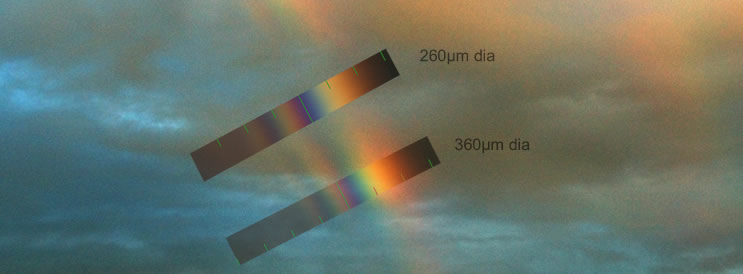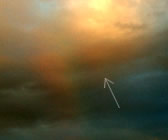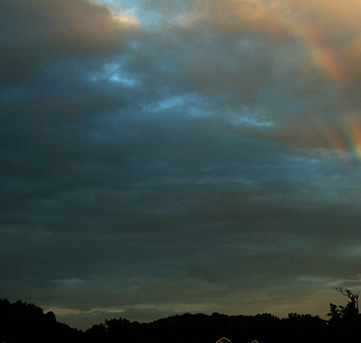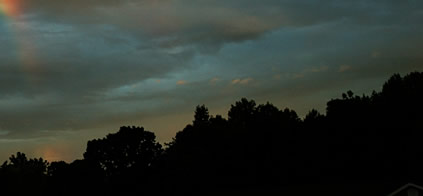| |
The display occurred for a few minutes before sunset and the bows
are consequently reddened. The unusual
aspects were (1) the two diverging fans of up to 3-4 narrow coloured
arcs inside the primary, (2) Indents in the primary at the levels
where the sets of multiple arcs were most widely separated and
(3) a very faint coloured arc outside the secondary bow.
What was happening?
Multiple bows, reflection bows, are sometimes
produced by sunlight reflected off sheets of water. However, the
nearest water was 28 km to the West and 56 km to the SouthEast.
The multiple bows were also too narrow and wrongly placed
for reflection bows. Violent showers sometimes produce the enigmatic ‘twinned
bows’ but
Statesville bows do not look like them and
there were no violent showers or hail.
The clue is the faint and broad arc outside the secondary bow.
It is a secondary
supernumerary. Supernumeraries inside the primary bow are not
unusual but a supernumerary to the secondary is very
rare. That it is present and so bright tells us that in that region
the raindrops
(1) had a narrow range of sizes and
(2) they were less than 0.4mm (400 micron) diameter [G.P.
Konnen, ''Appearance of the supernumeraries of the secondary
rainbow in rainshowers, J Opt Soc Am A, 4, 810-816 (1987)].
The existence of small raindrops with a narrow range of sizes
also explains the multiple
arcs inside the primary. They are supernumeraries to the
primary bow. They are not their usual colours because they
are produced by sunset reddened rays.
Why the fan-like spacing?
When raindrops are less than ~0.4mm dia the spacing of
supernumeraries widens as the drops get smaller.
Usually showers have their smallest drops at their edges. What
we have here are localised showers in which the drop size varied
smoothly from small drops to larger ones across a small part
of the sky and so produced the fan-like structure.
We can estimate the sizes of the drops involved. The angular
scale of the image can be found
from the red, orange, and green separations of the main primary
and secondary bows. That then allows rainbows simulations
by Airy scattering
theory to
be superimposed and compared with the actual supernumerary
spacings.

The simulations used a distribution
of drop sizes around each mean value characterised by a
standard deviation of 15%. The simulations match the spacings
of the upper and lower parts of the ‘fan’ reasonably.
The upper simulation tells us more. As the drop size decreases
the main primary bow shrinks slightly. This is the reason for
the two indents.
Why were so many supernumeraries visible?
Usually you see one or two. Here, the arcs were widely spaced
because of the small drop sizes. The reddened light stopped blue
light from reducing the contrast. And the drops were of closely
similar size. When the size spread in the simulations was increased
to 20% the outer arcs were not visible.
In summary:
That evening over Statesville there were several localised showers
that produced fragments of a primary and secondary rainbow. Some
showers had raindrops smaller than 0.4mm with a very narrow range
of sizes. These produced bright primary supernumeraries and a
very rare secondary supernumerary. The drop size varied smoothly
across two areas of sky and so produced supernumeraries of smoothly
changing spacing that gave them a unique fan-like structure. A
sight like this does not occur very often!
|
|

Secondary supernumerary |








